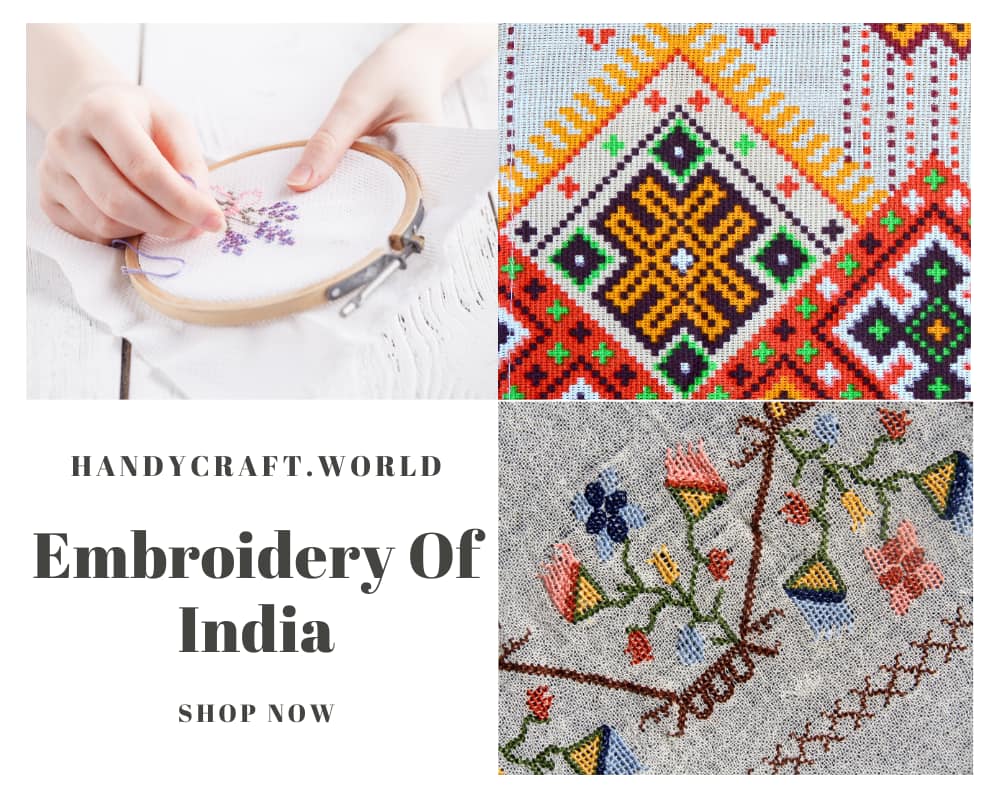India is truely blessed with these rich and vibrant cultures, heritage and legacies that will nourish many generations that the world will see. The country is also gifted with an immense amount of skills and talents, greater or smaller. It’s the grace of the lord one should feel so grateful to be born and to be living in this beautiful land.
One of the greatest talents India is blessed to have is art and crafts- the magic woven and stitches by the artists here in so many different regions. The artisans, craftsmen, handicrafts, embroidery designs artists and all those who earn their living by making these art wonders truely create a symphony altogether and Indian Embroidery Designs – a diverse yet the most extensive element of how one could define Indian Handicrafts.
Indian Embroidery Designs : At a Glance
Embroidery designs are formed on the idea of the texture of the material and stitch. Embroidery designs can also include materials aside from threads, like pearls, beads, stones and sequins. Influenced by the varied cultures that India has imbibed through innumerable invasions and settlements, embroidery from every region features a flavour of its own. So much in order that you’ll name the state an embroidery is from just by watching it.
Be it the robust handwork of Gujarat or the subtle and complex weaves of UP’s Chikankari, each embroidery stands out for its unique sort of stitches and use of fabrics and colours. Embroidery Designs of India stands out for unique stitches and use of fabrics and colours. Nurtured within the hinterlands of India by humble craftsmen, Indian embroideries, today, have the planet fawning over them. While India is known for its beautiful embroidery techniques, we have simplified and handpicked some embroideries that have been inspiring generations of designers over the years. India has rich varieties of Embroidery Designs like Chikankari, Chamba Rumal, Kashidakari, Kasuti etc..
Chikankari

Chikankari from Lucknow may be a delicate and complex embroidery designs style that’s believed to possess been introduced by Nur Jehan, the wife of Mughal emperor Jahangir. While the art flourished under the patronage of the Mughals, references to the art are found as early because the 3rd century BC with Megasthenes mentioning the utilization of flowered muslins by Indians.
A chikan piece is made by block printing patterns thereon. Craftsmen then embroider stitches alongside the pattern, and therefore the finished piece is later washed to get rid of traces of the prints. Traditionally, Chikankari began as a kind of white-on-white embroidery designs, but today the craft uses a spread of materials and hues.
There are three sorts of stitches utilized in chikankari: Flat stitches, like Taipachi (running stitch), Ghaspatti (fill with petals and leaves), Pechani (running stitch in regular manner), Bakhia (herringbone stitch, done on both sides of the fabric) and Thurs (cross stitch done on the proper side of the fabric). Embossed stitch like Hool (buttonhole), Gitti (buttonhole and satin), Murri (French knot), Phanda (French knot), Janjira (chain stitch). Jali work is that the most striking feature of chikankari, creates a fragile net effect on the material.
Zardozi
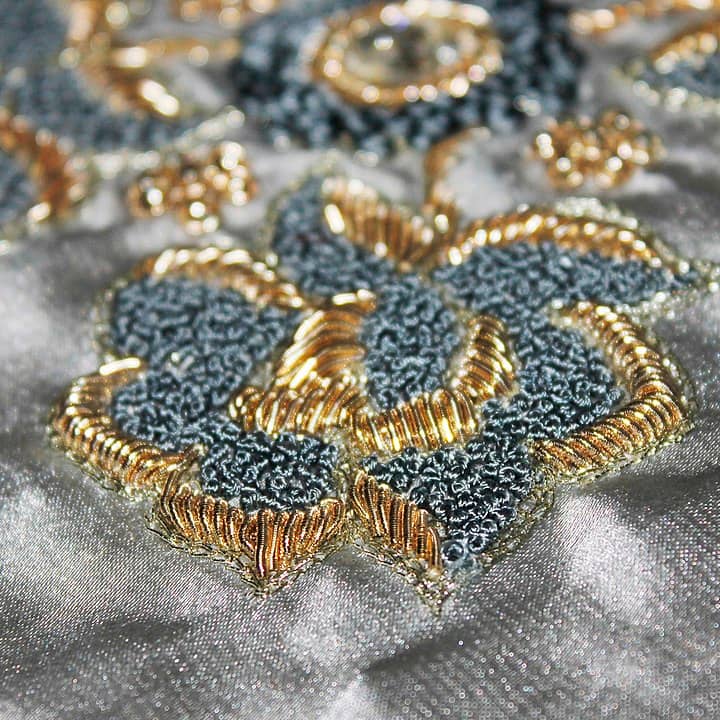
The hand embroidery designs of the royals, a combination of two words, ”zar” meaning gold and “dosi” meaning embroidery, is painstakingly laborious but exquisitely beautiful. It is gorgeous and unmatched in its appeal because in it thinnest metal threads are used to create intricate, tightly embroidered motifs. It was generally done on fabrics made from precious yarns or lush weaves like velvets.
Zardosi is heavy work, as it uses metallic threads along with beads and pearls – and hence, needs a solid fabric base. Even today, there’s a sense of royalty that is associated with zardozi work – and it is still seen as one of the most important hand embroideries of India. Though, known to be present in India since the age of Rig Veda, the Persian form of embroidery Zardosi became famous in our country, due to the patronage of the Mughal king Akbar.
It was originally done in yarn made from precious metals of gold and silver, so it was the treasures limited to royalty. It dwindled when the Mughal emperor Aurangzeb ceased to extend his support towards this art form due to its high costs and rare raw materials. Zardosi is a form of hand embroidery designs, where craftsmen draw out the design on the base fabric, stretch the fabric over a wooden frame for support and then use needles for embroidering, using yarns.
In ancient times, pure gold and silver yarns were used for this embellishment – along with pearls and precious stones. Copper wires with gold/silver/ bronze polish have replaced the pure ones, and beads, sequins and semi-precious stones are used now. Silk thread is also used, alongside metallic yarn. Zardozi lehengas and sarees are every Indian bride’s favourite!
Phulkari
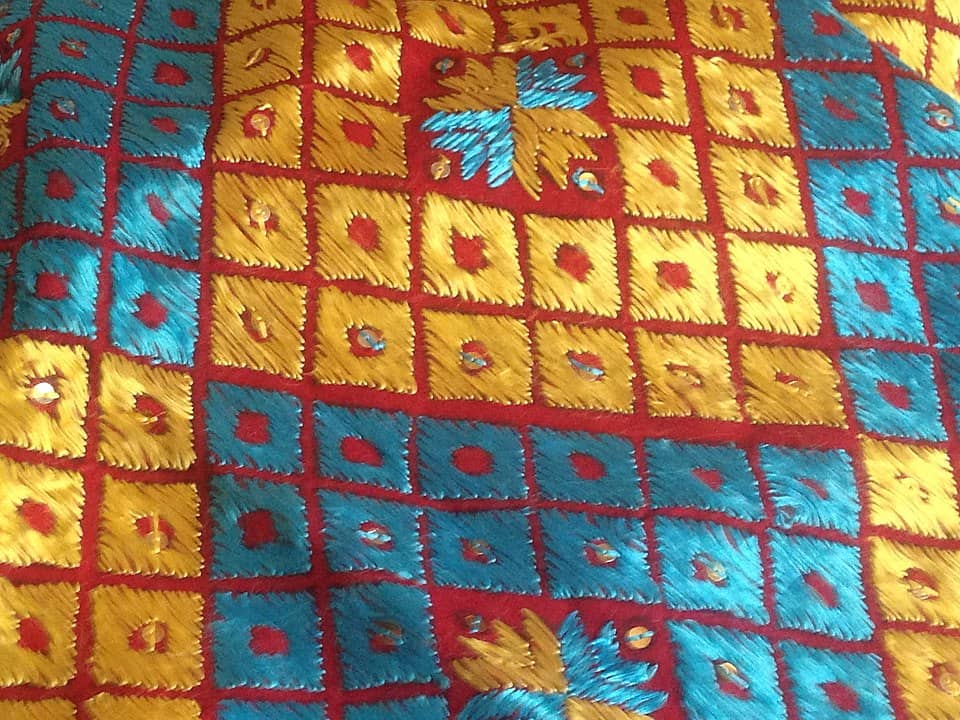
A kind of embroidery designs famous in Punjab, it translates to “flower work.” Phulkari is worn over the generations as shawls and headscarves, the tradition has been passed down through the generations. The ones for everyday use were known as phulkaris while the fully embroidered fabric worn on special occasions were called Bagh. These were part of the girl’s wedding trousseau in earlier times.
Floss silk thread is used for the embroidery and the material used is generally hand woven coarse fabric. In baghs, the cloth is not visible at all due to the heavy embroidery. In recent times, this kind of embroidery has been adopted and promote by fashion designers to incorporate the artwork in mainstream fashion.
Kantha
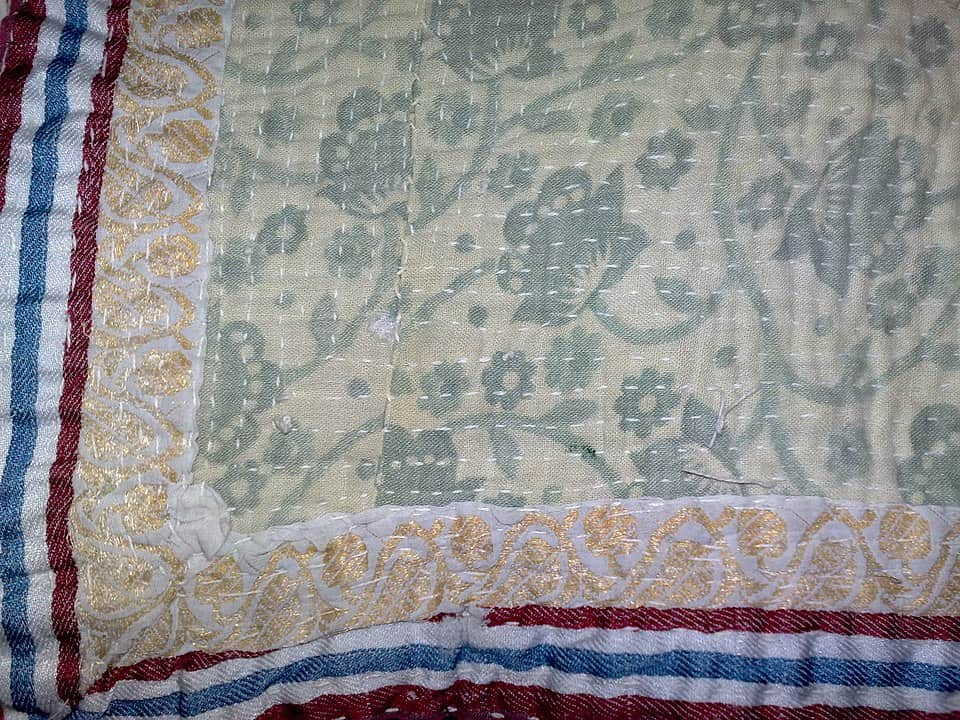
Popular in West Bengal and Orissa, this kind of embroidery designs is a symbol of the craftsmanship that is displayed by rural women. Originally, it was a kind of weave used for quilts or dhotis, but it has found its way into mainstream garments, and women frequently adorn Kantha Sarees. It dates long back and was traditionally used for stitching together old clothes and make something new.
Traditionally, women used old sarees and stacked them up and sewed them together to make blankets. Simple running stitches are used to create beautiful and striking designs. A slightly wrinkled effect on the cloth is obtained, and everyday themes like birds, flowers and shapes form the core of Kantha embroidery designs. Kantha work is known for its simplicity.
Aari

One of the most painstaking and laborious embroidery designs techniques, albeit the one that gives brilliant, unrivalled results, the ancient hand embellishment of Aari uses a unique hook and looping method. A sharp-edged, long needle with a hook at the end is used with thread and sequins/ beads to create chain stitch loops in this fine, delicate art. Aari gets its name from the same hooked, sharp needle that is used to create the embellishment, by making thread loops in which a variety of beads/sequins are inserted.
The art originated in the Mughal era, and today places like Rajasthan and Lucknow are best known for this work. Slightly different forms are also practised in parts of Kashmir and Kutch. Variations like Aari-Tari, a popular form of Aari done with metallic wires and sequins/kundan/gota are practised too. The fabric is stretched over a wooden frame and is often roughly stitched on it from the four sides to ensure it doesn’t slip. Cotton, silk or zari yarns can be used. It is very time consuming, and thus, many traditional practices are either being done away with or are improvised upon/ mixed with to reduce the effort.
The hooked pointed needle is first used to create a stitch – then, the thread is fed from the under-side with hand, and is pulled out on the right side – to create a loop in which the bead is inserted, and then a chain stitch is done. The meticulous workers of this art can embroider in a manner that looks effortless (picking the embellishments with the needle’s hook) – but it’s all quite difficult.
Kashidakari
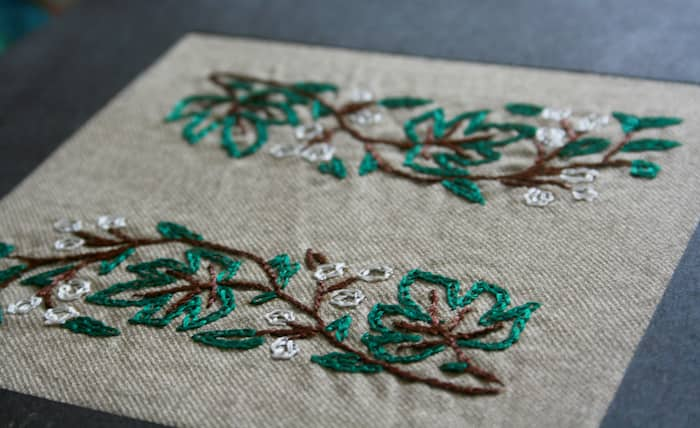
What started as a talented craft, soon became a source of domestic employment as farming within the harsh winters wasn’t possible. A unique feature of Kashidakari is the Kashmiri teapot. Known for its simple chain stitches, this embroidery designs is done mostly on silk and wool is a global rage. More popularly known as Kashmiri embroidery designs, Kashidakari evolved under the rule of Mughals.
Kashidakari is inspired by nature. Most common themes in Kashidakari embroidery include birds, flowers, trees, creepers etc. This is made and done by using chain stitch on cotton, silk and wool as base fabrics. Thread colours are inspired by the local flowers of Kashmir. Only one or two Kashidakari stitches are used to complete the entire embroideries. Craftsmen generally used shades that blend well with the background that overall makes it unique and beautiful Kashidakari Designs. Craftsmen family has involved themselves into carrying forward their rich tradition of kashidakari designs skills to their younger generations.
Chamba Rumal

Chamba Rumal is an artistic handicraft, originated in the valley of Chamba in the 18th century. This embroideries is executed on mulmul, hand-spun, hand-woven, coarser khaddar. The untwisted, and dyed silk threads ‘Pat’ in bright colours like red, orange, yellow, green, blue, crimson and purple are used for the embroideries. The Chamba Rumal embroidery designs uses double stitch which simultaneously fills within the motif on each side of the material, making it reversible.
The motifs are used, inspired by Pahari paintings, depicting Lord Krishna and his playful antics. The Chamba Rumal embroideries also depicts the flora and fauna of the Himalayan region. The embroidery is executed on a square piece of fabric but the Chamba Rumal embroidery is completed on fabrics like silk, polyester or terrycloth and made into blouses, caps, slippers, cushion covers etc. embroidered silk wall hangings are also exported from Himachal Pradesh.
Chamba Rumal Craftsmen are working hard on their design to make it beautiful. These Chamba Rumal Embroideries are practised by lot of women artisans in rural area. Now Made In India and Handmade India campaigns are promoting such Chamba Rumal Embroideries to be adopted in India.
Kasuti
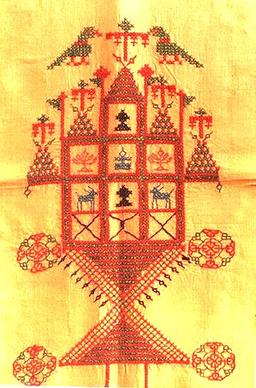
The name Kasuti (Kannada) springs from the words Kai (means hand) and Suti (means cotton), indicating an activity that’s done by hand on cotton that’s a traditional sort of folk embroideries, practiced within the state of Karnataka. Kasuti has been a main occupation and source of income for several rural women from that region. Kasuti embroidery designs involve four sorts of stitches (menthi, gavanti, negi and murgi). ‘Menthi’ is cross-stitch resembling fenugreek seed.
‘Gavanti’ is the double running stitch used for creating vertical, horizontal or diagonal lines. ‘Negi’ is a simple running stitch that produces a wave-like effect and ‘Murgi’ is a zigzag stitch. The motifs are inspired by everyday objects that may include religion, architecture, flora and fauna, and culture of this region etc. using a combination of horizontal, vertical and diagonal stitches, and require lots of patience; skill and intricacy since both the side of the Kasuti embroidery look alike. Presently Kasuti embroidery is additionally done on home products like cushion covers, bedcovers, curtains, etc. Kasuti Embroidery has been helping lot of rural women in Karnataka state. Now Kasuti is being exporting out of India.
Mirror Work
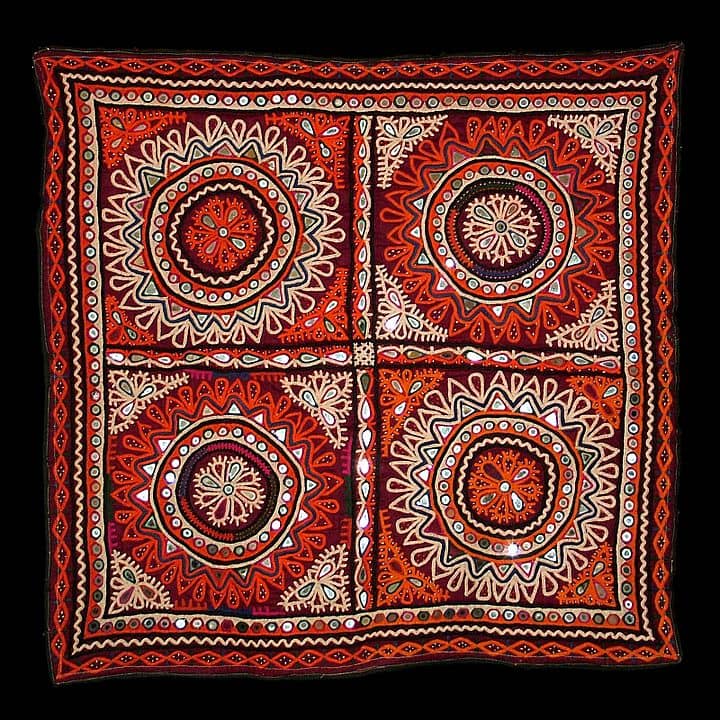
Shisha or mirror embroidery uses small mirrors to reflect the metal to the fabric is a popular craft from Gujarat and Rajasthan. The Mughal Empire saw the primary sorts of this art within the 17th century. Available in three types (hand-blown shisha, machine cut shisha and shisha embroidery), this craft stands out due to its use of mirrors and vibrant threads. This embroidery is made by using small pieces of mirrors of varied shapes and sizes, stitched in between colourful embroidery. While clothes embellished with mirror work are must-haves for Navratri festivities, this sort of labour also adorns bags, accessories, decorative pieces and residential decor.
Shop Now to show your support to Artisans and Designers in this COVID time.


